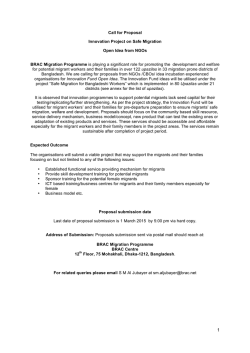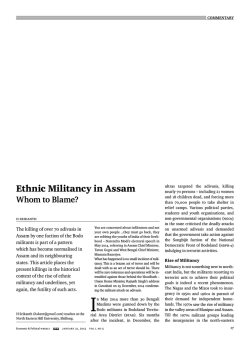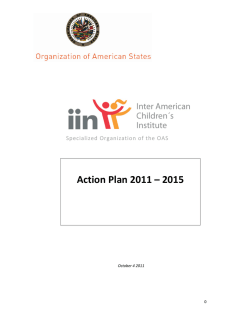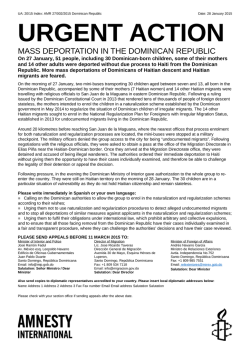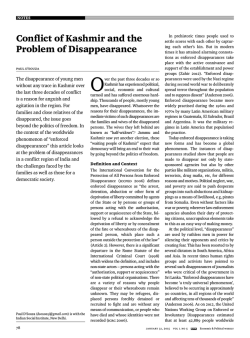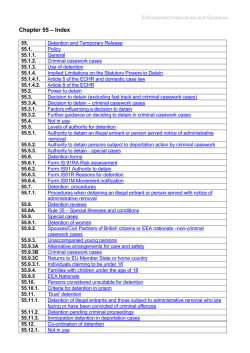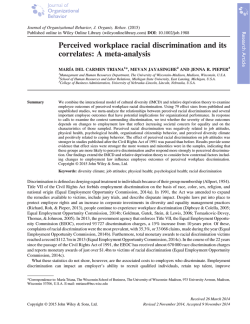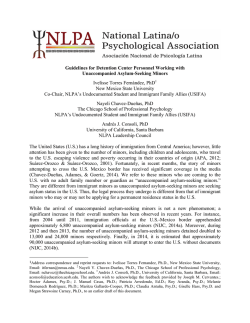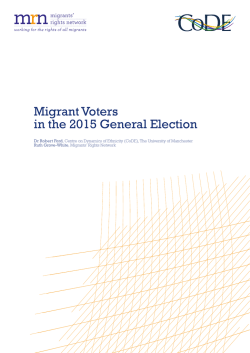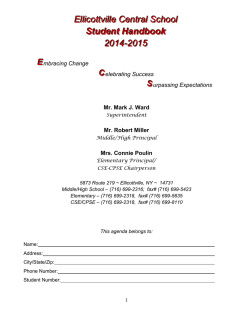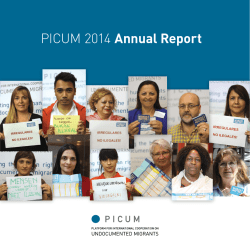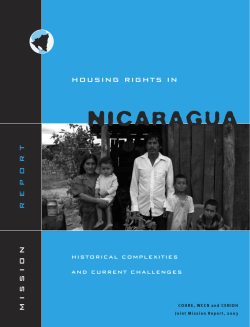
Questionnaire in English - Organization of American States
QUESTIONNAIRE FOR STATES AND CIVIL SOCIETY TO ASSIST IN THE PREPARATION OF THE ANNUAL OVERVIEW OF THE HUMAN RIGHTS SITUATION IN THE HEMISPHERE Article 59 of the Rules of Procedure of the Inter-American Commission on Human Rights (IACHR) provides that in Chapter IV of the Annual Report, the Commission will include in Section A, “an annual overview of the human rights situation in the hemisphere, derived from its monitoring work, which shall identify the main tendencies, problems, challenges, progress and best practices of civil and political rights, and social, economic and cultural rights.” The present questionnaire has been created to collect information from States and civil society to be considered in the preparation of Chapter IV.A of the IACHR’s 2014 Annual Report with respect to the topics of citizen insecurity; State compliance with the recommendations of the IACHR, the decisions of the Inter-American Court of Human Rights (IACtHR) and the human rights standards of the inter-American system; discrimination on the basis of ethnic or racial origin; and migrants. The Commission invites the States and civil society to submit their responses to this questionnaire providing examples of the most emblematic issues that demonstrate patterns or obstacles, as well as good practices, by February 23, 2015, to the following address: Inter-American Commission on Human Rights Organization of American States 1889 F Street, NW Washington DC, 20006 [email protected] The topic of the e-mail should be: Consultation Chapter IV.A. Citizen Insecurity 1. Homicide rate. Please indicate the overall yearly murder rate for every 100,000 persons in the territory of the State over the past five years. Also, whenever possible, provide such rates considering different aspects such as age, sex, ethnic or racial origin, economic stratum, urban/rural locations, and any other categories available. 2. Protection provided by security forces to those who receive and denounce threats. Please describe the existing framework of protective measures, including the procedure for requesting and granting measures employed by State security forces to ensure the safety of persons who receive and denounce threats and request protection. Also indicate any recent initiatives taken to address any past failures of this system and/or to improve these protective measures, as well as any initiatives to expedite the procedure for accessing and granting requests for protection. 3. Unlawful killings, forced disappearances and use of excessive force by State security forces. Please describe the existing framework for investigating unlawful killings, forced disappearances and the use of excessive force by State security forces. Please indicate any recent initiatives of laws, policy or practice taken to improve this framework in order to provide accountability for abuses committed by State security forces. 4. Targeting of justice operators and members of security forces by organized crime. Please indicate whether justice operators and members of the State security forces are particularly vulnerable to attacks carried out by organized crime and what recent measures have been adopted by the State to address this issue. Also indicate any cases of State officials involved with drug trafficking and measures taken to address this problem. Also indicate any positive results from the State’s initiatives. 5. Control of firearms and ammunition. Please describe the existing framework for controlling and monitoring the sale of legal firearms and ammunition to private citizens. Also describe the existing framework for combating the illegal flow of heavy firearms and ammunition to criminals. Indicate any recent initiatives that may negatively or positively affect or have already affected these frameworks. 6. Private security forces. Please indicate the number of private security forces operating within the State. Please indicate whether the State has mechanisms in place to monitor the private security forces operating in its territory and if so describe them. State Compliance with Recommendations of the Inter-American Commission and Decisions of the Inter-American Court of Human Rights and the Human Rights Standards of the Inter-American System 7. Conditions of detention and violence in detention facilities. Please indicate any recent initiatives taken by the State to improve the conditions of detention and to safeguard the physical and mental well-being of detainees, including adults and children, being held in any of the State’s detention facilities in order to comply with recommendations of the IACHR, decisions of the IACtHR and the standards of the inter-American human rights system. Also indicate the number of detainees in the country and their location by sex and age over the last five years. 8. Right to know the truth and accountability for grave human rights violations. Please indicate recent initiatives taken by the State to address grave human rights violations committed in the past and to ensure accountability for such violations. Also indicate efforts made to find victims of forced disappearances. 9. Military jurisdiction and human rights violations. Please describe the current framework and competence of the country’s military justice system. Describe recent initiatives that have been taken to ensure that human rights violations are investigated and prosecuted according to the standards set forth in the treaties of the inter-American human rights system and the decisions of the Inter-American Commission and Court of Human Rights. 10. Positive examples of compliance. Please describe examples of measures taken in compliance with recommendations of the Inter-American Commission that have proven to have a significant positive effect on the protection of human rights at the national level. 2 Justice: Discrimination on the Basis of Ethnic or Racial Origin 11. Laws, practices and judicial decisions that disproportionately affect persons or populations of a particular ethnic or racial origin in a disproportionate manner. Please indicate the existence of any laws, administrative practices and/or judicial decisions that disproportionately affect the ability of persons or populations of a particular ethnic or racial origin to enjoy the political, civil, social, economic and cultural rights to which they are entitled. 12. Inclusion policies. Please indicate any recent initiatives taken to promote and safeguard the human rights of persons who have experienced discrimination on the basis of their ethnic or racial origin. 13. Deprivation of liberty of persons of a specific ethnic or racial origin. Please indicate whether the State conducts studies to determine whether the deprivation of liberty is a measure that disproportionately affects or that is disproportionately applied to persons who belong to specific ethnic and racial groups. Please indicate the absolute number of the country’s prison population for every 100,000 persons and provide a comparison of that number to the incarceration rate of persons from distinct ethnicities and races. 14. Killings by State security forces. Indicate whether the State compiles data on the number of persons of a particular ethnic and racial origin who are killed in a lawful and/or unlawful manner by State security forces. If yes, indicate the process and criteria utilized in determining whether that person’s death was lawful and indicate the absolute and relative numbers of lawful and unlawful deaths of these persons as compared to the general population. If possible, disaggregate the information by age, sex and urban or rural locations. Migrants 15. Immigration detention. Please indicate whether the State deprives persons in an irregular migratory situation of their liberty based on that status and, if so, describe the legal framework under which they are held in detention (duration, rights, legal representation, judicial review, etc.). Please indicate whether special measures are afforded to children, pregnant and nursing women, families, and other groups in a situation of vulnerability. Also describe the facilities and conditions in which migrants are detained. 16. Refugee status determination procedures. Please describe the refugee status determination procedures in place in the country, the number of persons who arrived to the State in 2014 and requested recognition of refugee status or asylum, and the number of cases where the State recognized the refugee status and/or granted asylum. Also indicate any other measures, such as humanitarian visas, adopted by the State to protect vulnerable migrants arriving to the State. 17. Deaths of migrants and other persons in the context of human mobility along migratory corridors, both land and sea. Indicate whether this is an issue that the State had to deal with in 2014 and, if so, the number of such cases that were registered in 2014. Also indicate how criminal investigations of such cases were conducted and the percentage of such investigations carried out over the last five years that resulted in prosecutions and/or convictions. 18. Civil, political, economic, social, and cultural rights of migrants. Please indicate recent measures and initiatives taken to promote the inclusion of migrants into their new society, such as access to social programs and benefits, and to ensure the civil, political, economic, social, and cultural rights of migrants are protected and respected. Also indicate what kind of protection and monitoring mechanisms are in place to ensure that migrant workers are not exploited or subjected to slave-like working conditions and that they are 3 fairly treated and compensated for their work. Also inform whether there is a mechanism available and accessible for migrant workers to file complaints regarding human rights violations. 4
© Copyright 2026
